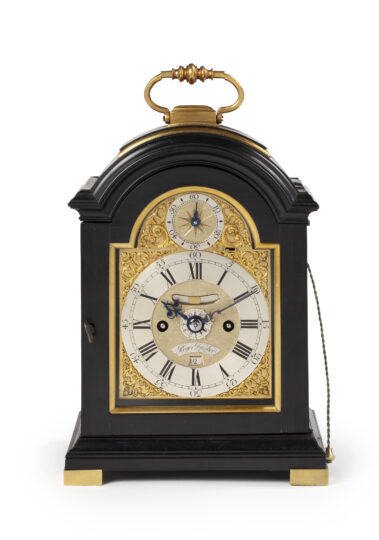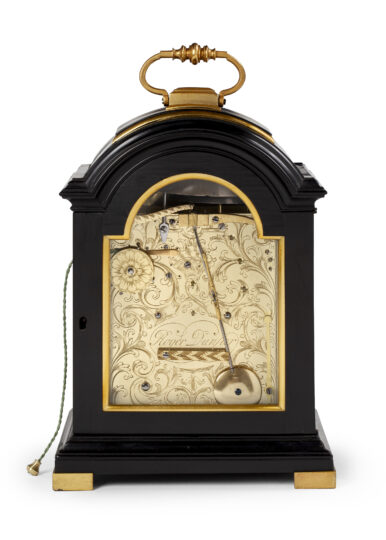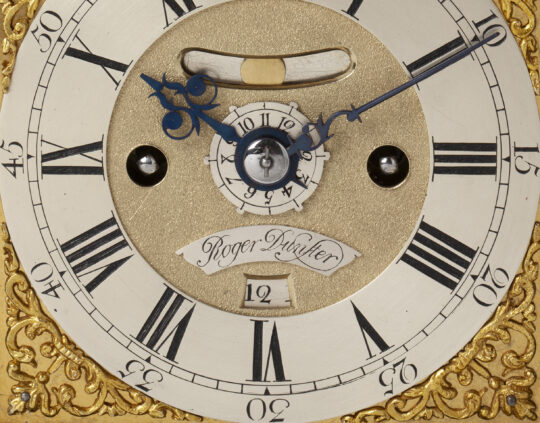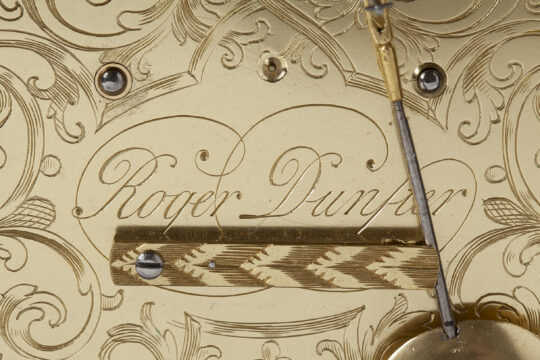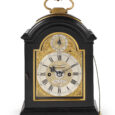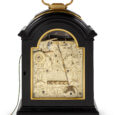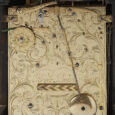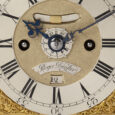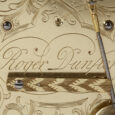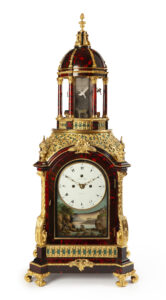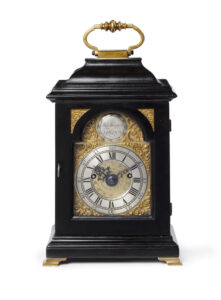SMALL BRACKET CLOCK Signed Roger Dunster Ca. 1740 The Netherlands
M&R29
SMALL BRACKET CLOCK
Signed Roger Dunster
Circa 1740
The Netherlands
Movement
The spring-driven double chain fusee brass movement is constructed between two rectangular plates and consists of going, striking and alarm trains. The going train has a verge escapement with a short pendulum. The rack striking is of the “Dutch striking” type, which means that on the hour the number of hours is indicated in full on a low-pitched bell and on the half hour the number of hours of the next hour is indicated on a lighter bell. The striking can also be repeated by pulling a cord on the left side of the case. Finally, the clock has an alarm that is also activated with a pull cord on the other side of the clock. The back plate is richly engraved depicting scroll motifs and the signature Roger Dunster
Dial
The arch-shaped brass dial has a silvered chapter ring with black Roman hour numerals, Arabic numerals for the five minutes and strokes for the other minutes in a ring. The time is indicated by two pierced blued-steel hands. The two winding holes are located on either side of the centre. Above the VI is a date aperture surmounted by a silvered plaque with the signature of the maker: Roger Dunster. There is a false pendulum aperture above the middle. The silvered brass alarm disc is mounted behind the hands. It has Arabic hour numerals. The alarm time is indicated by the tail of the hour hand. There is a strike/silent button above the I. The silvered chapter ring in the arch around a matted centre with a star motif in the middle has Arabic numerals and a blued steel hand. With this hand the going train can be regulated. In the four corners of the dial next to the chapter ring and next to the chapter ring in the arch are cast gilt brass spandrels.
Case
The arched, ebony-veneered oak case has arched windows on all sides, which are set in brass frames. The doors at the front and rear are also arched. The case is surmounted by a brass carrying handle. The whole rests on four brass block feet.
Duration: 1 week
Height: 23 cm (with handle up 28 cm).
Width: 17 cm.
Depth: 13 cm.
Literature
– H.M. Vehmeyer, Clocks, Their Origin and Development 1320-1880, LC 98.
– H.M. Vehmeyer, Antieke klokken, een familieverzameling, p. 602.
– E. Morpurgo, Nederlandse klokkenmakers en horlogemakers vanaf 1300, p. 36.
The maker
Roger Dunster (c. 1695-1747) was a watch and clockmaker in both London and Amsterdam. In 1722 he became the partner of Christopher Clarke in Amsterdam. The business operated under the name ‘Clarke and Dunster’. Clarke (1668-1734) worked together with Ahasuerus II Fromanteel around 1694 under the name Fromanteel & Clarke, in Amsterdam. Fromanteel died in 1703 and Chr. Clarke continued to use the firm name until 1722 when Dunster entered the business. This collaboration lasted until 1730, when Christopher Clarke decided to return to London. Roger Dunster continued the business under his own name. In 1744 he bought a house on the Vijgendam in Amsterdam. After his death in 1747, master clockmaker Abraham Bruykens took over the business.

